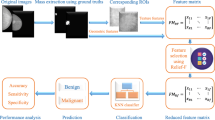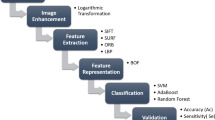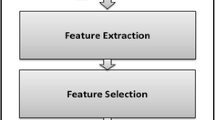Abstract
Computer-aided diagnosis of breast cancer is becoming increasingly a necessity given the exponential growth of performed mammograms. In particular, the breast mass diagnosis and classification arouse nowadays a great interest. Texture and shape are the most important criteria for the discrimination between benign and malignant masses. Various features have been proposed in the literature for the characterization of breast masses. The performance of each feature is related to its ability to discriminate masses from different classes. The feature space may include a large number of irrelevant ones which occupy a lot of storage space and decrease the classification accuracy. Therefore, a feature selection phase is usually needed to avoid these problems. The main objective of this paper is to select an optimal subset of features in order to improve masses classification performance. First, a study of various descriptors which are commonly used in the breast cancer field is conducted. Then, selection techniques are used in order to determine the most relevant features. A comparative study between selected features is performed in order to test their ability to discriminate between malignant and benign masses. The database used for experiments is composed of mammograms from the MiniMIAS database. Obtained results show that Gray-Level Run-Length Matrix features provide the best result.
















Similar content being viewed by others
References
Razavi AR, Gill H, Ahlfeldt H, Shahsavar N (2007) Predicting metastasis in breast cancer: comparing a decision tree with domain experts. J Med Syst 31:263–273
Smart CR, Hendrick RE, Rutledge JH, Smith RA (1995) Benefit of mammography screening in women ages 40 to 49 years: current evidence from randomized controlled trials. Cancer 75:1619–1626
Cady B, Michaelson JS (2001) The life-sparing potential of mammographic screening. Cancer 91:1699–1703
Bowes MP (2012) Digital mammography: process, guidelines, and potential advantages. eRadimaging. https://www.eradimaging.com/site/article.cfm
Tabar L, Fagerberg C, Gad A, Baldetorp L, Holmberg L, Grontoft O, Ljungquist U, Lundstrom B, Manson J, Eklund G et al (1985) Reduction in mortality from breast cancer after mass screening with mammography. Lancet 1:829–832
Bird RE, Wallace TW, Yankaskas BC (1992) Analysis of cancers missed at screening mammography. Radiology 184:613–617
American Cancer Society (2003) Cancer prevention and early detection facts and figures. American Cancer Society, Atlanta
American College of Radiology, ACR BI-RADS (2003) Mammography, ultrasound & magnetic resonance imaging, 4th edn. American College of Radiology, Reston
Bozek J, Mustra M, Delac K, Grgic M (2009) A survey of image processing algorithms in digital mammography. J Recent Adv Multimedia Signal Process Commun 231:631–657
Oliver A, Freixenet J, Mart J, Pérez E, Pont J, Denton ER et al (2010) A review of automatic mass detection and segmentation in mammographic images. Med Image Anal 14(2):87–110
Rojas Domnguez A, Nandi AK (2009) Toward breast cancer diagnosis based on automated segmentation of masses in mammograms. Pattern Recognit 42(6):1138–1148
Tang J, Rangayyan RM, Xu J, El Naqa I, Yang Y (2009) ‘Computer-aided detection and diagnosis of breast cancer with mammography: recent advances. Inf Technol Biomed IEEE Trans IEEE 13(2):236–251
Elter M, Horsch A (2009) CADx of mammographic masses and clustered microcalcifications a review. Med Phys Am Assoc Phys Med 36(6):2052–2068
Narváez F, Romero E (2012) Breast mass classification using orthogonal moments. In: Breast imaging. Springer, Berlin, pp 64–71
Haralick RM, Shanmugam K, Dinstein I (1973) Textural features for image classification. IEEE Trans Syst Man Cybernet SMC-3:610–621
Cheng HD, Shi XJ, Min R, Hu LM, Cai XP, Du HN (2006) Approaches for automated detection and classification of masses in mammograms. Pattern Recognit 39:646–668
Székely N, Tóth N, Pataki B (2006) A hybrid system for detecting masses in mammographic images. IEEE Trans Instrum Meas 55(3):944–952
Nunes AP, Silva AC, Paiva ACD (2010) Detection of masses in mammographic images using geometry, Simpson’s Diversity Index and SVM. Int J Signal Imaging Syst Eng Indersci 3(1):40–51
Khuzi AM, Besar R, Zaki WW, Ahmad N (2009) Identification of masses in digital mammogram using gray level co-occurrence matrices. Biomed Imaging Interv J 5(3):e17
Gonzalez RC, Woods RE (2002) Digital image processing. Prentice-Hall Inc, New Jersey, pp 76–142
Galloway MM (1975) Texture classification using gray level run length. Comput Graph Image Process 4:172–179
Tamura H, Mori S, Yamawaki T (1978) Texture features corresponding to visual perception. IEEE Trans Syst Man Cybernet Smc-8(6):460–473
Manjunath BS, Ma WY (1996) Texture features for browsing and retrieval of large image data. IEEE Trans Pattern Anal Mach Intell (Spec Issue Digit Libr) 18(8):837–842
Rodrigues JF Jr, Traina AJM, Traina C Jr (2005) Enhanced visual evaluation of feature extractors for image mining. In: The 3rd ACS/IEEE international conference on computer systems and applications
Tahir MA, Bouridane A, Kurugollu F (2007) Simultaneous feature selection and feature weighting using Hybrid Tabu Search/K-nearest neighbor classifier. Pattern Recognit Lett 28:438–446
Duda RO, Hart PE, Stork DG (2001) Pattern classification, 2nd edn. Wiley, New York
Peng H, Long F, Ding C (2005) Feature selection based on mutual information: criteria of max-dependency, max-relevance, and min-redundancy. IEEE Trans Pattern Anal Mach Intell 27(8):1226–1238
Vapnik V (1995) The nature of statistical learning theory. Springer, Berlin
Sun Y, Lou X, Bao B (2011) A novel relief feature selection algorithm based on mean-variance model. J Inf Comput Sci 8(16):3921–3929
Shalizi C (2010) Principal Component Analysis. Lecture Notes, 36–490, https://www.stat.cmu.edu/~cshalizi/490/10/pca/pca-handout.pdf.
Suckling J et al (1994) ‘The mammographic image analysis society digital mammogram database. In: Exerpta Medica, international congress series 1069, pp 375–378
Robnik-Šikonja M, Kononenko I (2003) Theoretical and empirical analysis of ReliefF and RReliefF. Mach Learn J 53:23–69
Author information
Authors and Affiliations
Corresponding author
Rights and permissions
About this article
Cite this article
Chaieb, R., Kalti, K. Feature subset selection for classification of malignant and benign breast masses in digital mammography. Pattern Anal Applic 22, 803–829 (2019). https://doi.org/10.1007/s10044-018-0760-x
Received:
Accepted:
Published:
Issue Date:
DOI: https://doi.org/10.1007/s10044-018-0760-x




